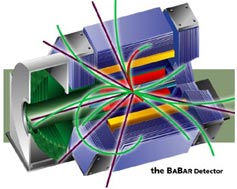

Wednesday - October 3, 2007
SLAC Today is
available online at:
http://today.slac.stanford.edu
In this issue:
PEP-II Delivers Half an Inverse Attobarn to BaBar, With More to Come
People Today: Gail Fong
Pief, Remembered
Use Energy Wisely
 |
 |
|
Wednesday - October 3, 2007 |

The PEP-II accelerator has reached a milestone, delivering enough particle collisions for the BaBar detector to observe 500 million pairs of B and anti-B particles.
PEP-II Delivers Half an Inverse Attobarn to BaBar, With More to ComeThanks to a steady push during the course of eight years, the PEP-II accelerator has now delivered double the amount of data originally expected when the BaBar experiment first started up in May of 1999. Between then and September 4, 2007, when Run 6 concluded, PEP-II has generated a remarkable half an inverse attobarn of integrated luminosity—a measure of the number of particle collisions in a given period of time. This corresponds to 500 million pairs of B and anti-B particles, whose decays have yielded major discoveries this decade. The sheer quantity of data is reshaping the kind of physics that can be investigated. PEP-II's achievement is a testament to hard work, as well as continual upgrades and adjustments to a machine built with the capacity for future improvements. The accelerator now regularly operates with four times the luminosity, or collision concentration, it was designed to deliver. Higher luminosity translates into more accurate results and the ability to find otherwise unobservable physics, such as matter–antimatter asymmetry in rare "penguin" type decays. Read more... |
||
|
|
||
|
Pief, Remembered
Whether they knew him for five minutes or for 50 years, it seems that everyone who encountered Pief Panofsky has at least one story about him—he was just that kind of unforgettable person. As a way of celebrating and remembering him, the SLAC Archives and History Office would like to collect any of your "Pief Stories" that you would like to share, be they funny, serious, casual, profound, or somewhere in-between. On the Pief Stories website, please tell us a little bit about yourself, how you met Pief, and then tell us your particular Pief Story. The SLAC Archives and History Office will gather these together to share with the community as a lasting memorial to SLAC's first Director, the original, unique and irreplaceable W. K. H. "Pief" Panofsky. Use Energy WiselyWhen selecting office task lighting, consider safer, more efficient ENERGY STAR lamps over popular halogen lamps which have been known to be a safety concern, according to the U.S. Consumer Product Safety Commission. While halogen lamps are relatively inexpensive to purchase, they are relatively more expensive to operate, and create a lot of unnecessary heat in summer, adding to cooling costs. |
Events (see all | submit)
Access (see all)
Announcements
|
| | ||
|
|
||
 <%
Response.AddHeader "Last-modified", getArticleDate()
'Response.AddHeader "Last-modified","Mon, 01 Sep 1997 01:03:33 GMT"
'Monday, December 06, 2010
%>
<%
Response.AddHeader "Last-modified", getArticleDate()
'Response.AddHeader "Last-modified","Mon, 01 Sep 1997 01:03:33 GMT"
'Monday, December 06, 2010
%>View online at http://today.slac.stanford.edu/. |
||